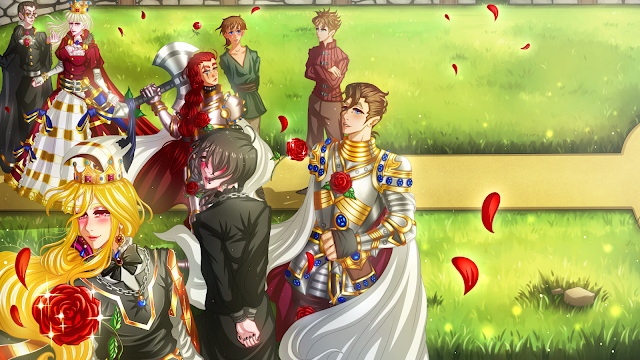Trials, Triumphs, and Lessons Learned from 8 Successful Video Game Releases and 3 Humbling Failures
How my game dev journey started -- The story behind "The Prince's Heart".
- The team consisted of junior game developers who were developing a game for the first time, so we underestimated how much time it would actually take to complete them.
- Our team was also participating in another jam, which I'm going into detail in the following section. It's a no-brainer that this would increase our workload, but at the time it seemed like a good idea to participate in a short jam because I wanted us to have another portfolio piece and boost the team's morale with a quick victory.
Lessons learned and contributing factors to delays
O2A2 Jam: Dragon Gazer -- The first game I completed was the second I started
Lessons Learned from a short jam
Fighting Grief by Developing multiple projects.
The events spanning from 2021 to 2022 will likely leave an indelible mark on my psyche for the rest of my days. Right after completing "The Prince's Heart," my father contracted COVID-19, and shortly after Christmas, he passed away. As if this blow wasn't enough, my grandfather succumbed to grief exactly two months later, on his birthday, in a cruel twist of fate. My grandmother's dementia worsened, and she lost touch with reality after my father's passing. Reflecting on the events of those two months and the hardships I endured still feels surreal to me. I won't delve into the specifics of the challenges faced during that time or the lingering unresolved matters they left behind – that's not the focus of this post. What kept me grounded amidst the chaos was my dedication to developing video games. Pouring myself into coding, writing, and game design served as a kind of therapy. Each new game project offered a refuge from the grief. I eagerly accepted every game dev offer that came my way. However, taking on too much eventually led to my downfall. I bit off more than I could chew, and the repercussions of my overloaded schedule would soon become evident.
I managed to release "The Prince's Heart" just days after my father fell ill with COVID-19. At that time, a fellow writer approached me with a request to adapt his Twine script into a visual novel (VN). This project presented a unique challenge due to its intricate branching narrative. While Twine made crafting complex narratives seem effortless, translating those intricacies into a visual novel engine posed its own set of challenges, from naming conventions to tracking branching paths using flags. On the bright side, creating assets for this VN was relatively straightforward, as Re:Shape was intended as a mobile game for Android – offering an opportunity to diversify our portfolio.
Given that many of my colleagues were junior developers, progress on our projects proceeded slowly, affording me the chance to engage in multiple tasks simultaneously. Consequently, I found myself juggling production, game design, writing, and programming duties. Production consumed a significant portion of my time, prompting me to explore joining another team, either as a programmer or designer. When I stumbled upon a newly formed group, I couldn't resist.
The project lead, a junior programmer, recognized my production skills and enlisted my help in organizing the team. When we settled on an idea, the project leader stepped back, leaving me in charge of production and design for "The Sinking of Dream Chaser." The challenge lay in using Unity, an engine I had little experience with. Despite internal struggles, I chose to continue with both projects simultaneously.
As my workload grew, I sought to lighten the burden by recruiting another programmer for Re:Shape, but with no success. Eventually, I coded the mobile game myself.
A year had passed, and my team and I had completed four games. The only game pending release was "The Sinking of the Dream Chaser," stalled in the programming department due to my unfamiliarity with Unity. Lacking the energy to learn a new engine, and with another Yaoi Jam approaching, I opted to start a new project, despite being a bad idea. Drawing from my experience crafting visual novels, I implemented strict guidelines akin to O2A2 Jam to ensure timely delivery. With a team of three artists, we divided the workload into manageable chunks. This phase of my game dev journey proved relatively smooth, given my experience and the project's manageable scope. In a stroke of luck, I recruited two additional programmers, one of whom was highly skilled, enabling us to complete "The Sinking of the Dream Chaser."
With 2022 coming to a close, I participated as a producer/programmer in a couple more projects that were successfully released.
I had finally released eight projects, and then it all came crashing down. I hit a wall.
My Unfinished Games: A Journey of Acceptance
Now I had three more games to finish: Calamity Sin, a 3D horror game with fixed camera angles reminiscent of the original Resident Evil 2; Town of the Damned, a sprawling visual novel boasting around 300k words; and Rogue Shifters, a Yaoi VN with gameplay elements, clocking in at approximately 50k (written by me).
Several factors contributed to these failures: the lack of programming support, scope creep in the first two projects, mainly due to the demands of parenthood. Mental pressure mounted from all sides, and I made the difficult decision to pull the plug. These games loomed large for a small team. Don't misunderstand me; I thrive on challenges and the desire to see projects through to completion. However, sometimes it's wiser to acknowledge failure and let go.



.png)
.png)
Comments
Post a Comment